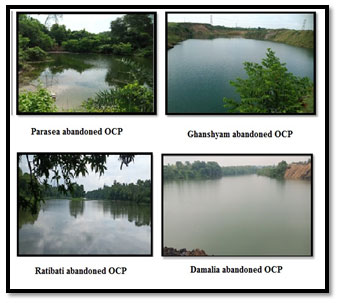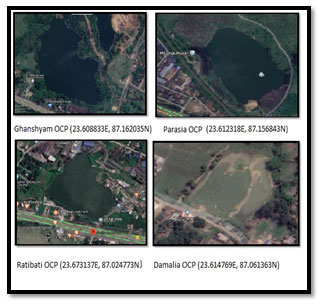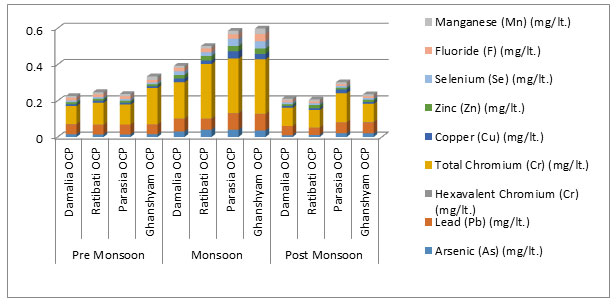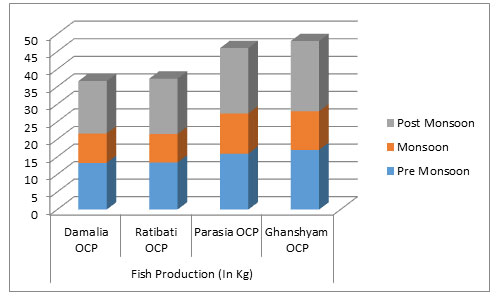1Department of Botany, The University of Burdwan, West Bengal, India
2Department of Geography, Chatra Ramai Pandit Mahavidyalaya, West Bengal, India
3Vice Chancellor, The University of Burdwan, West Bengal, India
Corresponding author email: saha.buruniv@gmail.com
Article Publishing History
Received: 19/10/2020
Accepted After Revision: 12/12/2020
Open cast pit (OCP) filled with surface runoff and groundwater recharge. A total of 40 PLs were enumerated and characterized to determine their nature, position,
depth, area and comparative account in RCF during the period of 2014–2017. A 1-year study of physicochemical parameters of water and soil was recorded at 27 selected mine PLs to understand its quality. During the study period, the 14 most frequently cultured/naturally occurred fish species were collected and identified from the PL. PLs aged over 20–30 years turned naturally into wetland ecosystem harbouring a good amount of aquatic biota, excellent water quality and stabilized embankment. The present study is based on the relationship between seasonal variation of heavy metals and fish diversity. During the analysis it is found that there is a direct impact on heavy metal concentration in these OCPs during different seasons.
It was observed that concentration level differed among OCPs due to their different geographical location. Monsoon is the most vulnerable season for heavy metals concentration and pit lakes of Satgram area were more contaminated than those of Kajora Area. As a result of it, fish diversity and fish production were high in Parasea OCP and Ghanshyam OCP than Damalia OCP and Ratibati OCP and it may also be stated that post monsoon is most productive season in terms of rich fish diversity and fish production. The main aim of the work was to find out the relationship between the seasons and heavy metals concentration and its impact on fish diversity. It also gave emphasis to find out the probable measures for improvement of fishery sector.
Heavy Metal (HM), Open Cast Pit, Physiochemical Parameter, Surface Runoff, Fish Diversity, Wetland
Saha D, Saha A, Saha N. C. Seasonal Variation of Heavy Metals and Fish Diversity in Different Open Cast Coal Mine Pits of Satgram and Kajora Areas Raniganj, West Bengal, India. Biosc.Biotech.Res.Comm. 2020;13(4).
Saha D, Saha A, Saha N. C. Seasonal Variation of Heavy Metals and Fish Diversity in Different Open Cast Coal Mine Pits of Satgram and Kajora Areas Raniganj, West Bengal, India. Biosc.Biotech.Res.Comm. 2020;13(4). Available from: https://bit.ly/3n00EfH
Copyright © Saha et al., This is an Open Access Article distributed under the Terms of the Creative Commons Attribution License (CC-BY) https://creativecommons.org/licenses/by/4.0/, which permits unrestricted use distribution and reproduction in any medium, provide the original author and source are credited.
INTRODUCTION
In 1774 coalmining in India was first initiated in the Raniganj Coalfield, in Bengal province. Rich treasure of coal was found near Ethora, presently in Salanpur community development block by John Sumner and Suetonius Grant Heatly of the British East India Company. The exploration and mining operations were haphazard in early stage. Alexander & Co started regular mining in 1820. In 1835, after the collieries had been bought by Prince Dwarkanath Tagore the field was led by Carr Tagore and Company. The country witnessed Ranigunj coalfields as the major producer of coal for the entire 19th century and a major part of the 20th century (Chattopadhyay, 2001).
But Coal mining activity badly affected the ecology, atmosphere, land, human health and water system viz. the surrounding environment of mining area. (Peplow and Edmonds, 2002; Younger, 2004). After completion of coal extraction, the pit is filled up by surface runoff and groundwater discharge. Then the pit becomes a water body or water reservoir (commonly called as Khadan) (Ghosh et al., 1984; Ghosh et al., 2005). Coal mining activity is a significant resource of soil and its heavy metal contamination (Liu et al., 2020).
The pit water body is mainly contaminated by the materials that are present in the adjoining top soil. The soil commonly contains toxic chemicals, pollutants, heavy metals etc. i.e. less nutrients for the growth of the angiosperms or any other plants (Ghose, 2001; Dutta and Agrawal, 2002; Johnson, 2003; Ghose, 2004; Razo et al., 2004; Pagnanelli et al., 2004; Marín-Guirao et al., 2005; Mercuri et al., 2005; Maiti, 2007; Bhuiyan et al., 2010; Sheoran et al., 2010; Das and Chakrapani, 2010). In Raniganj coalfield, the pit water contains high concentration of metals like Fe, Cu, Zn, Co, Cr, Mn, Pb, Cd, etc., leads to metal pollution in the coal pit ecosystem (De and Mitra, 2002).
The pit-lake aquatic system depends on the physicochemical composition and nature of the bottom sediment and the growth and development of autotroph (like macrophytes) solely depend on the sediment of a water body that is called as the reservoir of nutrients (Barko and Smart, 1986). The availability of zooplankton from an OCP has lots of versatile bio indicating properties (Das and Chakrapani, 2011).These are: short life cycles, adaptation to changes of environment, vast distribution in various aquatic ecosystems, correlation in-between nutrient and energy cycles, and indicating to sudden environmental disturbances like acidification, thermal conditions, pollution, water flow and level of salinity, etc. (Litchman et al., 2013; Lokko et al., 2017; Pociecha et al., 2017; Zhao et al., 2018).
The scarcity of water is a regular problem in Raniganj coalfield area which is supplied water by rain fed rivers – Damodar, Ajay and Barakar. This problem can be solved by of getting water stored in the open cast mine pits of this area and at the same time these water bodies can be used for pisciculture (Tiwary and Dhar, 1994). This present study aims at finding out how the accumulated heavy metals make an impact on fish diversity in different pits of two areas of Eastern Coalfield Limited in Raniganj coalfield in respect of different seasons.
MATERIAL AND METHODS
Study Area:The present study sites Ratibati & Damalia are now abandoned OCPs since 2017 and 1989 respectively, situated in Satgram area which is geographically around 23.674889°N Lat and 87.082754°E Long in Asansol sub div and Parasea & Ghanshyam OCPs both are abandoned since 2015-16 in Kajora area, located around 23.632407°N Lat and 87.171593°E Long in Durgapur sub div, Paschim Bardhaman. The Satgram and Kajora areas both are in E.C. Ltd. The Satgram area is surrounded by the Sripur Area and Kunustoria Area on the North, Kajora Area /Andal CD Block on the East, Bankura district on the South and Asansol sub div on the West. The Kajora area is confined by the Kenda Area on the North, Bankola Area on the East, Andal CD Block on the South, and Kunustoria Area on the West.
Figure 1: Images of Four OCP
Figure 2: Satellite View of Four OCPs
The primary samples were collected from four study sites of three consecutive seasonal phases, these are pre monsoon, monsoon and post monsoon seasons. After that these were brought to the laboratory for analysis by using APHA 23rd Edition, 1060. Parameters like As, Pb, Cr, Cu, Zn, Se, F, Mn were considered for observation. So many statistical methodologies were used in this study to explore the actual result. Arithmetic mean, ANOVA, frequency distribution (bar or comparative bar) was used. Standard protocols and methodologies were maintained during sampling and analyses of the mine water (BIS 1987).
Whereas Correlation statistics was performed by using SPSS statistical software version 16.0 for analysing the data set and get better result. To know the seasonal nature of fish diversity in different abandoned OCP Shannon Weiner’s Species Diversity Index (SDI) was applied. It is the most useful statistical tools to determine the species diversity in different time scale or in different area or condition. The formula used for Shannon Weiner’s Species Diversity index:

Where, H = Shannon-Weiner species diversity index (SDI); Pi = ni/N (ni = Number of individuals of ith species and N= total number of individuals of all the species in the quadrate).
RESULTS AND DISCUSSION
For this study, water samples were collected from 4 OCPs for heavy metals analysis, among which Damalia and Ratibati OCP fall under Satgram area of E.C. Ltd. and Parasea and Ghanshyam OCP fall under Kajora area of E.C. Ltd. Various types of heavy metals, i.e. As, F, Se, Zn, Cu, Cr, Pb, Mn were taken into consideration for the study. Due to high amount of heavy metals channelized through surface runoff in monsoon months, the water quality deteriorated in high scale. On the other hand, the rate of contamination decreased in pre-monsoon and it becomes the lowest in post-monsoon.
So, it must be argued that post monsoon months are very favourable for aquatic ecosystem as well as fish breeding. Among the HM concentration, level of Chromium (Cr) and Lead (Pb) is very high in all season in respect of other HM, but its level is maximum in monsoon months in all four OCPs. As and Se level were observed also high in respect other two seasons. Permissible limit as per MoEF (Ministry of Environment and Forest) schedule-VI standard is the scale of consideration for measuring the magnitude of HM concentration in different seasons.
Table 1. Season Wise and OCP Wise Concentration Of Heavy Metal
| HEAVY METALS | Pre Monsoon | Monsoon | Post Monsoon | Permissible Limit as per MoEF Schedule-VI Standard | |||||||||
| Damalia OCP | Ratibati OCP | Parasia OCP | Ghanshyam OCP | Damalia OCP | Ratibati OCP | Parasia OCP | Ghanshyam OCP | Damalia OCP | Ratibati OCP | Parasia OCP | Ghanshyam OCP | ||
| Arsenic (As) (mg/lt.) | 0.015 | 0.014 | 0.014 | 0.015 | 0.03 | 0.04 | 0.04 | 0.036 | 0.01 | 0.011 | 0.02 | 0.02 | 0.2 |
| Lead (Pb) (mg/lt.) | 0.055 | 0.053 | 0.054 | 0.054 | 0.07 | 0.06 | 0.09 | 0.09 | 0.05 | 0.04 | 0.06 | 0.06 | 0.1 |
| Hexavalent Chromium (Cr) (mg/lt.) | 0.001 | 0.001 | 0.001 | 0.001 | 0.002 | 0.002 | 0.002 | 0.002 | 0.001 | 0.001 | 0.001 | 0.003 | 0.1 |
| Total Chromium (Cr) (mg/lt.) | 0.1 | 0.12 | 0.11 | 0.2 | 0.2 | 0.3 | 0.3 | 0.3 | 0.1 | 0.096 | 0.16 | 0.1 | 2 |
| Copper (Cu) (mg/lt.) | 0.01 | 0.011 | 0.01 | 0.01 | 0.02 | 0.02 | 0.04 | 0.03 | 0.01 | 0.01 | 0.02 | 0.01 | 3 |
| Zinc (Zn) (mg/lt.) | 0.01 | 0.011 | 0.01 | 0.01 | 0.02 | 0.025 | 0.03 | 0.03 | 0.01 | 0.018 | 0.01 | 0.012 | 5 |
| Selenium (Se) (mg/lt.) | 0.01 | 0.01 | 0.01 | 0.01 | 0.02 | 0.02 | 0.04 | 0.04 | 0.01 | 0.01 | 0.01 | 0.01 | 0.05 |
| Fluoride (F) (mg/lt.) | 0.015 | 0.016 | 0.015 | 0.014 | 0.02 | 0.021 | 0.025 | 0.04 | 0.01 | 0.01 | 0.01 | 0.01 | 2 |
| Manganese (Mn) (mg/lt.) | 0.01 | 0.011 | 0.013 | 0.02 | 0.01 | 0.013 | 0.019 | 0.03 | 0.01 | 0.01 | 0.011 | 0.01 | 2 |
Figure 3: Showing season wise HM concentration in Four OCPs
Table 2. Two-way ANOVA for showing Season wise and OCP wise variation of significant levels of HM concentration
| ANOVA ON PRE MONSOON SEASON DATA | ||||||
| Source of Variation | SS | df | MS | F | P-value | F crit |
| Between HM’s | 0.0475 | 7 | 0.0067 | 22.5226 | 1.35 | 2.7641 |
| Between Seasons and OCPs | 0.0006 | 2 | 0.0003 | 1.1553 | 0.343238 | 3.7388 |
| Error | 0.0042 | 14 | 0.0003 | |||
| Total | 0.0524 | 23 | ||||
| ANOVA ON MONSOON SEASON DATA | ||||||
| Source of Variation | SS | df | MS | F | P-value | F crit |
| Between HM’s | 0.1988 | 7 | 0.0284 | 571.4103 | 4.22 | 2.7641 |
| Between Seasons and OCPs | 0.0007 | 2 | 0.0003 | 7.4107 | 0.006381 | 3.7388 |
| Error | 0.0006 | 14 | 4.97 | |||
| Total | 0.2002 | 23 | ||||
| ANOVA ON POST MONSOON SEASON DATA | ||||||
| Source of Variation | SS | df | MS | F | P-value | F crit |
| Between HM’s | 0.0328 | 7 | 0.0046 | 27.0924 | 4.21 | 2.7641 |
| Between Seasons and OCPs | 0.0005 | 2 | 0.0002 | 1.4996 | 0.25 | 3.7388 |
| Error | 0.0024 | 14 | 0.0001 | |||
| Total | 0.035763 | 23 | ||||
Notes: SS = Sum of Squares, df = Degree of Freedom, MS = Mean Sum of Squares, Fobs = Observed F, P- value = Probability, Fcrit = Critical F.
Two-way ANOVA was also computed to analyse the significant level among HM’s in different seasons and the significant variation in respect of season wise concentration of HM’s in four OCPs. From pre-monsoon ANOVA (Table 2), it is said that there is significant difference in respect of different HM’s (Fobs>Fcrit) but among seasons and in terms of OCPs, there is no significant difference (Fobs<Fcrit). From ANOVA on monsoon data regarding season wise and OCP wise HM’s concentration (Table 2), it is shown that there is significant difference in terms of both cases, i.e. different HM’s and Seasonal variation in OCPs (Fobs>Fcrit).ANOVA on post-monsoon data (Table 2) represents the same condition like pre-monsoon time, like significant difference in respect of different HM’s (Fobs>Fcrit) but among seasons and in terms of OCPs, there is no significant difference (Fobs<Fcrit).
Rather, it is also found that the significance level is higher in all post-monsoon months. Season wise and OCP wise nature of fish diversity was also calculated using Shannon Weiner’s Species Diversity Index, which is very well known index for measuring fish diversity in various aspects. More or less 14 fish species are found in these 4 OCPs during various seasons. These fishes have common names like rui, catla, calbaus, silver carp, punti, bata, mrigel etc. In all the OCPs, the most available fishes are rui, catla, calbasu, silver carp, mrigel. But their amount is varied during various seasons. Table 3 shows that the highest fish diversity (H) was found in post monsoon months, i.e. 2.37 and lowest diversity (H) seen in monsoon months, i.e. 2.28.
Table 3. Season wise and OCP wise fish diversity (H)
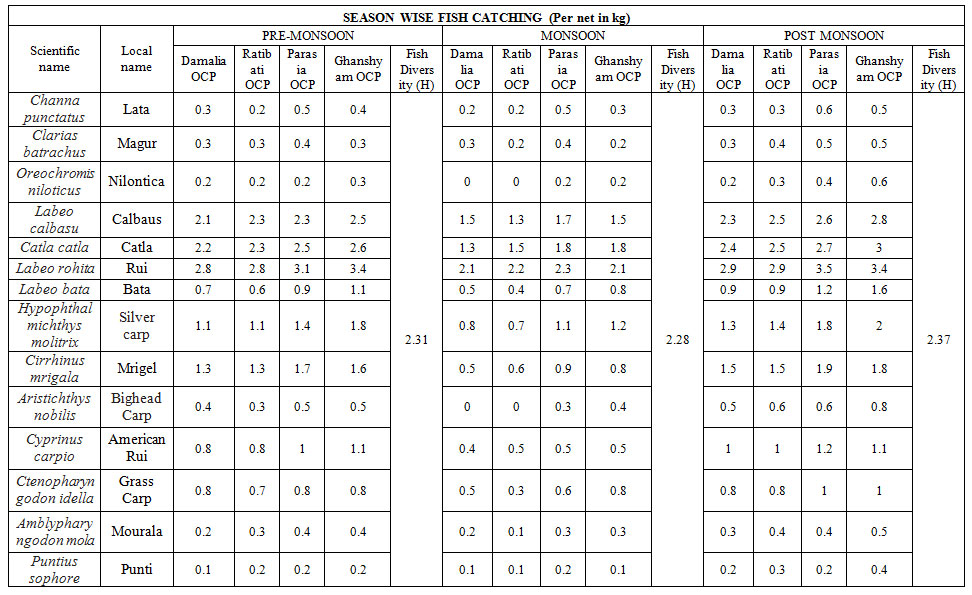
Figure 4: Season wise and OCP wise fish production (in kg)
In respect of fish production (Figure 4), post-monsoon months are the highest productive months then other seasons. It is also showing that Parasea and Ghanshyam OCP of Kajora Area (ECL) are more productive than Damalia and Ratibati OCP of Satgram Area (ECL).
OCP wise productions of fishes are varied as:
Ghanshyam OCP>Parasea OCP>Ratibati OCP>Damalia OCP: West Bengal is a state covered by tropical monsoon season. Out of 3 seasons, i.e. Summer, Winter and Rainy season, Rainy or monsoon season is the dominant season. It comes after the long summer. During hot summer, huge amount of water vapour is released over the sky of Arabian sea and the Bay of Benagal.
Figure 5: Fishing activity
Trade wind move towards land mass (impact of corriolis force ) as the high pressure belts are prevailling at Indian land mass. Due to formation of densed cloud, exsessive amount of rainfall occurs throught the gangetic plain land. As a result of intensive rainfall, large volume of rain water flows as a surface runoff. These runoff water is contaminated with heavy metals, pollutants (both biotic and abiotic) etc. So the `inland water bodies also may be contaminated. In Raniganj area, OCPs are filled with this runoff water as well as ground water. But the water recharge basically happens during monsoon months through drainage and contaminated water. These OCPs are too deep in nature. Due to season wise variation of contamination, fish diversity is also varied. Top soil parameters are also the key factors to the nature of contamination. It may be stated that as the rainy season is the most affective time in terms of HM contamination, fish diversity and fish production is low at that time.
But due to the lowest rate of contamination in dry winter or post-monsoon months, high fish production and fish diversity are observed. On the other hand the HM concentration is low in the OCPs of Kajora Area than OCPs of Satgram Area. So fish production and fish diversity are higher in Parasea and Ghanshyam OCP than those in Damalia and Ratibati OCP. This observation is justified by Palit and Kar (2019) investigation that 15 most frequently naturally or cultured fish species occure under 4 orders, 5 families and 14 genera that were collected and identified from the OCP in Raniganj coalfield. After the analysis of OCP water quality and questionnaire survey of the local peoples, it is recomendated that pisciculture project can be initiated in 25 OCPs. OCPs aged more then 20 years turned naturally into wetland, harbouring a good amount of aquatic diversity, excellent quality of water without any restriction.
CONCLUSION
There are various future scopes regarding the optimum use of OCP water. It is observed that low nutrient level often minimises the fish foods and thus availability of primary production. It may be used for artificial or well managed fishing activities by the local people as sustainable developmental tools. For implementation of successful and sustainable fishing activity, pit lake fisheries need more considerations and attention on water quality, habitat and food sources which are the most important determinants. As these OCPs are too deep, trawl netting may be introduced for fishing. Post-monsoon-based planning may be initiated in that area as it is more productive and diversified season. Chemical water treatment through filtration may be introduced during rainy season. On the other hand, generally good water quality in OCP water contains elevated COPC which may bio magnify the OCP ecosystem and actually prevent a risk to end users and make profit for fisher men as well as local inhabitants. Proper training should be given to the local fisher men for advanced fishing techniques and procedure regarding OCP based fish production.
REFERENCES
Barko JW and Smart RM (1986) Sediment‐related mechanisms of growth limitation in submersed macrophytes Ecology, Vol 67 No 5, Pages1328-1340
Bhuiyan MAH, Parvez L, Islam MA, Dampare SB and Suzuki S (2010) Heavy metal pollution of coal mine-affected agricultural soils in the northern part of Bangladesh Journal of Hazardous Materials, Vol 173 No 1-3, Pages 384-392
Chattopadhyay A (2001) Bardhaman Jelar Itihas O Lok Sanskriti Talk: Bardhaman, Vol I, Pages 46-51
Das SK and Chakrapani GJ (2011) Assessment of trace metal toxicity in soils of Raniganj Coalfield India Environ Monitoring and Assessment Vol 177, Pages 63-71
De S and Mitra AK (2002) Reclamation of mining-generated wastelands at Alkusha–Gopalpur abandoned open cast project, Raniganj coalfield eastern India Environmental Geology, Vol 43, Pages 39-47
Dutta RK and Agrawal M (2002) Effect of tree plantations on the soil characteristics and microbial activity of coal mine spoil land Journal of tropical ecology, Vol 43 No 2, Pages 315-324
Ghose MK (2001) Management of topsoil for geo-environmental reclamation of coal mining areas Environment geology, Vol 40 No 11, Pages 1405-1410
Ghose MK (2004) Effect of opencast mining on soil fertility Journal of scientific and industrial research, Vol 63 No 12, Pages1006-1009
Ghosh M and Singh SP (2005) A review on phytoremediation of heavy metals and utilization of it’s by products Asian J Energy Environ, Vol 6 No 4, Pages18
Ghosh SK, Singh TPN and Tiwary RK (1984) Quality of mine waters in Jharia coalfield IAWPC TECH ANNUAL, Vol XI, Pages 25-28
Johnson DB (2003) Chemical and microbiological characteristics of mineral spoils and drainage waters at abandoned coal and metal mines. Water air soil pollution Vol 3, Pages 47-66 https://doi.org/10.1023/A:1022107520836
Litchman E, Ohman MD and Kiørboe T (2013) Trait-based approaches to zooplankton communities J Plankton Res Vol 35 No 3, Pages 473–484 https://doi.org/10.1093/plankt/fbt019
Liu X, Shi H, Bai Z (2020) Heavy metal concentrations of soils near the large opencast coal mine pits in China Chemosphere, Vol 244, April 125360 https://doi.org/10.1016/j.chemosphere.2019.125360
Lokko K, Virro T and Kotta J (2017) Seasonal variability in the structure and functional diversity of psammic rotifer communities: role of environmental parameters, Hydrobiologia, Vol 796 Pages 287–307 https://doi.org/10.1007/s10750-016-2923-3
Maiti SK (2007) Bioreclamation of coalmine overburden dumps-with special emphasis on micronutrients and heavy metals accumulation in tree species, Environmental Monitoring and Assessment, Vol 125 Pages 111-122 https://doi.org/10.1007/s10661-006-9244-3
Marín-Guirao L, Cesar A, and Marín A (2005) Establishing the ecological quality status of soft-bottom mining-impacted coastal water bodies in the scope of the, Water Framework Directive Marine pollution bulletin, Vol 50 No 4 Pages 374-387
Mercuri AM, Duggin JA and Grant CD (2005) The use of saline mine water and municipal wastes to establish plantations on rehabilitated open-cut coal mines Upper Hunter Valley NSW, Australia For ecological management, Vol 204 No 2-3 Pages 195-207
Pagnanelli F, Moscardini E, and Giuliano V (2004) Sequential extraction of heavy metals in river sediments of an abandoned pyrite mining area: pollution detection and affinity series, Environment pollution, Vol 132 No 2 Pages189-201
Palit D and Kar D (2019) A Contemplation on Pitlakes of Raniganj Coalfield Area: West Bengal India, In Sustainable Agriculture Forest and Environmental Management Pages 517-571, https://doi.org/10.1007/978-981-13-6830-1_15
Peplow D and Edmonds R (2002) Effects of Mine Waste Contamination on Fish and Wildlife Habitat at Multiple Levels of Biological Organization in the Methow River 2001-2002, Annual Report DOE/BP-00004710-2
Pociecha A (2017) Rotifer diversity in the acidic pyrite mine pit lakes in the Sudety Mountains (Poland) Mine Water Environ, Vol 37 No 3, Pages 518-527 https://doi.org/10.1007/s10230-017-0492-y
Razo I, Carrizales L, Castro J (2004) Arsenic and heavy metal pollution of soil water and sediments in a semi-arid climate mining area in Mexico, Water Air Soil Pollution, Vol 152 February, Pages129-152
Sheoran V, Sheoran AS and Poonia P (2010) Soil reclamation of abandoned mine land by revegetation: a review, International journal of soil sediment water, Vol 3 No 2, Pages 1940-3259
Tiwary RK and Dhar BB (1994) Environmental pollution from coal mining activities in Damodar river basin India, Mine water and the environment, Vol 13 No June-December Pages1-10
Younger PL and Wolkersdorfer C (2004) Mining impacts on the fresh water environment: technical and managerial guidelines for catchment scale management, Mine water and the environment, Vol 23, Pages S2-S80
Zhao K (2018) Factors determining zooplankton assemblage difference among a man-made lake connecting canals, and the water-origin river Ecol. Indic. Vol 84, Pages 488-496 https://doi.org/10.1016/j.ecolind.2017.07.052

